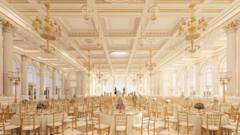The White House has officially announced plans to construct a new $200 million ballroom, a project that echoes the long-held wishes of President Donald Trump. This elegant addition, set to be built adjacent to a "modernized" East Wing, aims to address the limitations of the current East Room, which only accommodates about 200 guests. Press Secretary Karoline Leavitt emphasized that this much-anticipated ballroom would offer a seating capacity of approximately 650 attendees, reducing the reliance on temporary tents for large state events.
In a briefing on Thursday, Leavitt expressed that the ballroom would enhance the White House's ability to host grand events, which often feature high-profile guests, including world leaders. With construction scheduled to commence in September, funding has reportedly been secured from Trump and undisclosed donors, signaling a departure from the challenges he faced during the Obama administration when his previous offer of $100 million was not taken seriously.
The proposed design aligns architecturally with the White House’s existing structure, featuring opulent interiors complete with chandeliers and intricate columns. Leslie Greene Bowman, who has served on the Committee for the Preservation of the White House through four presidencies, articulated a desire for any alterations to honor the historical significance of the walls that have borne witness to the nation’s legacy.
While First Lady Melania Trump’s office and other East Wing functions will need temporary relocation during construction, the administration remains optimistic about merging modern enhancements with historical respect. Chief of Staff Susie Wiles remarked on the administration's dedication to preserving the White House's rich history while laying foundations for future generations.
Trump's desire for a ballroom is not new; he noted the impracticality of relying on tents for major events, critiquing their unsightliness. In recent remarks to European Council President Ursula Van der Leyen, Trump reaffirmed his intent to create a ballroom that could rival global standards. While previous proposals from Trump faced opposition, his administration appears determined to push through this ambitious project as a hallmark of his legacy.
As the funds and plans for this ballroom unfold, discussions regarding the balance between modernization and historical preservation continue to engage observant citizens and historians alike.






















